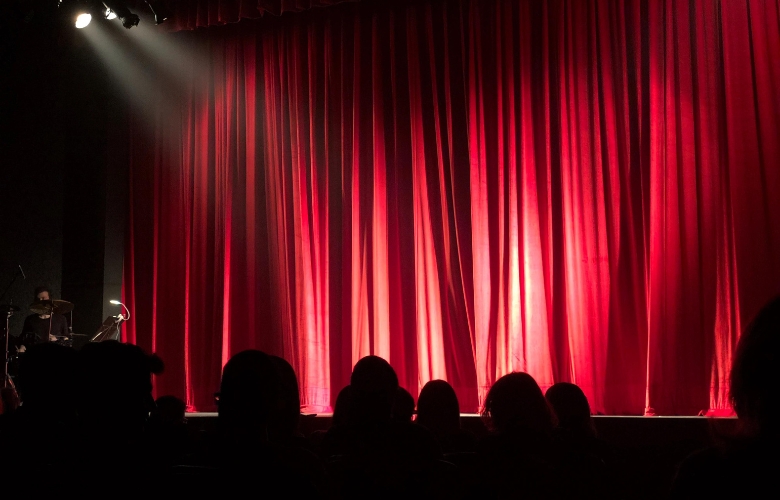
The theatre industry has seen a lot of challenges in the past few years, but these trials revealed that live stage performances are more important now than ever. Our post “10 Lessons from 2020 about Theatre & Stage Management” emphasizes that theatre is essential; as an art, it reflects a society’s cultures and values and unites communities, something desperately needed in times of crisis. It’s also amazing entertainment, a feast for the senses and emotions.
There’s no doubt that watching performers on stage is exciting—which is why the theatre was so missed when it was closed—but technical aspects like sound are just as important when bringing an audience into a scene. It’s this immersive quality that makes live theatre so engaging and life-changing for so many reasons. Here’s why sound design is vital for any production:
Beating Acoustic Limitations
Ensuring that audiences can clearly hear performers should be a top priority for sound designers. However, a venue’s acoustic capabilities, such as natural reverb and echo in a space, can pose unique challenges. Larger theatres will often have more of these qualities than a black box space or smaller theatre, and proper equipment can be used to work around these issues. As Shout4Music highlights, different types of microphones and sound equipment are suitable for live performances. Microphones like the MTP W950 Modular Condenser Microphone showcase how proper gear can prevent issues with durability and feedback during live performances. Wind noise and plosives coming from performers are also eliminated.
Developing Mood and Atmosphere
In live theatre, sound design is as important as lighting and sets when setting a mood or atmosphere for a particular show. The Conversation notes that Professor of music Gena R. Ghrer notes that when it comes to films, music, and sound go hand-in-hand with creating a visual impact for a scene. Beyond mood, sound can foreshadow events, reveal a character’s inner emotions, and underscore the ongoing action. The same principles apply to live theatre; a production need not be musical to use sound in a way that adds to a scene and conveys a particular emotion to audiences. Underscores are designed to enhance the atmosphere of a performance subtly. Sound effects can add an impactful element, such as a loud clap of thunder or glass breaking.
A scene may not reach its maximum potential without the proper sound design. Audiences may see the action unfold on stage, but the music and sound developed by a sound designer are essential for bringing the viewers into the world and touching their emotions.
Balancing Sound and Performance
Though music and sound are essential for a live theatre production, sound design ensures that these elements don’t overpower the performers. An understanding of the previously mentioned aspects of sound design can be used to find a good balance between the acoustics of a space and the necessary music or sound effects to configure how the sound is delivered effectively. This can include choosing between recorded or live soundscapes, which sound effects to keep or omit in a scene, the kind of equipment being used, and or finding the harmony between the performers’ voices and the sounds being played.
Sound design is integral to the life-enriching aspect of live theatre. Research from the Journal of Experimental Social Psychology found that the immersive and entertaining theatre experience can spark empathy for others. When you harness sound along with stunning performances, believable sets, and a touching story, you can shift the way people view the world. Delivering a good experience for audiences through sound design can help achieve this change.
For more expert guidance for stage management and the art and craft of theatre, check out The Symposium to find out how you can gain more insights and advice.
Written exclusively for Broadwaysymposium.com
by Abby Chelsea
What Quarterback Alex Smith Taught Me About The Theatre


The mission of the Broadway Stage Management Symposium is to create a safe and welcome place for stage managers to connect, share, learn and inspire. Each year, our annual event brings together the most experienced and highly-regarded Stage Management professionals on Broadway for a two-day program that offers practical insights, instruction, and inspiration for anyone interested in stage management. Through a variety of panels, Broadway’s stage managers share their experience, techniques, offer practical career advice, and answer questions. These sessions dive deep into important issues for stage managers of all levels, revealing insights into the why’s and how’s of stage management, that only come with the benefits of decades on Broadway. This unique forum presents opportunities to engage with top professionals as well as network with fellow attendees, exponentially growing professional relationships and opportunities. Past attendees have come from all over the U.S., as well as Argentina, Bolivia, Canada, Mexico, and Australia and some alumni have gone on to work on Broadway shows. By sharing their knowledge, Broadway stage managers give a hand up to the next generation, illuminate proven strategies for success, and advance the profession. As the leaders of a company, stage managers’ actions have a significant impact on a show and its participants. The Symposium helps stage managers develop the tools for successful leadership and stewardship. In this way, the Symposium can have a positive impact not only on stage managers’ career, but the industry at large. Please join us for our annual event and the ongoing conversation all year long over our social media platforms (twitter, Instagram, facebook & tumblr) as well as the Symposium blog.
Read Full Profile© 2021 TheatreArtLife. All rights reserved.

Thank you so much for reading, but you have now reached your free article limit for this month.
Our contributors are currently writing more articles for you to enjoy.
To keep reading, all you have to do is become a subscriber and then you can read unlimited articles anytime.
Your investment will help us continue to ignite connections across the globe in live entertainment and build this community for industry professionals.